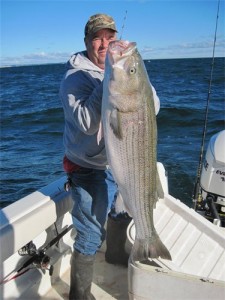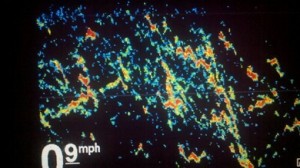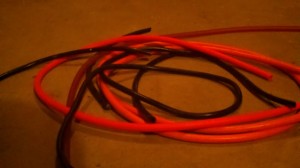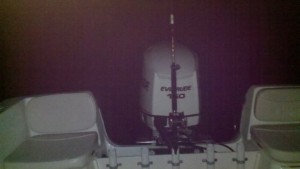So far it's been a great Cape Cod summer! There's been some nice bass around, the tuna bite (which I hope to get in on this September) has been incredible, and the weather has been pretty good too.
The best fishing of the entire season, for just about every species on Cape Cod, is just getting underway. For striped bass, you can not beat September and October-it's prime time!

So before we enter into THE BEST time of the year on Cape Cod (at least for us fishermen it is the best time of the year!) I wanted to take a look at some of the common things we all do that hinder our ability to catch fish. In this post in particular, we will take a look at why you may not be catching as many bass as you could be while trolling the tube and worm.
Have you had a couple trips this year when you marked bass, but caught nothing? Are the people around you "pulling em in" on the tube, while you troll around without a bump? Have you spent all day trolling, covering miles of water, without a single bass?
If so, join the group! We all have had unproductive trips at one point or another. Believe me I've had plenty. However, there are a few details that can have a big impact when trolling tubes.
Let's take a look at some of the biggest mistakes folks make when trolling the tube and worm.
1) Trolling in an area with no fish in it
This one seems like a no-brainer, but it happens all too often. Just because you are fishing in a well known "hot spot" such as East of Chatham, the Fingers, Race Point, or the Elizabeth Islands, it does not mean that you are in a hot spot for that particular trip.
Take a look around the next time you are on the water. In Cape Cod Bay in particular, the bass could really be just about anywhere. There's a TON of water out there to cover! I never put a line in the water until I mark at least one bass on my sonar. Marking even just one fish, amongst all this open ocean, is a big deal. Odds are that one bass under your transducer is but one of many bass in the immediate area.

2) Experimenting with different colors first, instead of depth and tube length
There's probably a boat load of folks who will disagree with me on this (which is A-OK) but I really do not see a need to carry tube colors other than red, black and maybe orange. I think hot pink, green, purple, brown and other color tubes are made to catch fishermen-and of course a few fish here and there. I used to carry orange but I don't any longer.
If you are coming up empty, but folks around you are catching fish, try paying closer attention to the depth and tube length they are using instead of color.
This happened to me not too long ago. The action was hot, but then strangely died. I initially thought the bite had shut off, but I noticed that my friend in another boat was still hitting them hard. I tried changing the amount of colors I was trolling and then changing the color of the tube. I continued catching nothing at all.

It was not until I realized that my friend was trolling an 18 inch red tube, instead of the 24 inch red tubes we had been catching them on all morning. Unfortunately I only had 18 inch black tubes on board. It didn't matter though to the fish, and as soon as they saw that 18 inch black tube they were all over it and we began catching again. I know, crazy!
I've also had countless instances in which I have been catching fish using 3 1/2 colors all trip. Then, for some reason, we stop catching but continue marking bass. A quick depth change to 4 colors did the trick and we began catching again. I may never understand the difference a half of a color makes to the fish-however I will never underestimate the importance.
If I'm not catching bass, but am marking bass on my sonar I will usually:
1) First experiment with amount of colors (depth)
2) Experiment with tube length
3) Experiment with tube color
3) Trolling only 2 tubes instead of 3
A couple of seasons ago I used to troll 4 tubes off my 21 foot boat. When I take people out fishing, I've found that trolling 3 tubes, all on leadcore, works a bit smoother.
Having that third tube in the water is beneficial for a couple of reasons.
1) It's another hook in the water for fish to bite, which instantly increases your fish catching ability. All other variables held constant, the boat trolling 3 lines will always out-fish the boat trolling just 2.
2) It allows you to experiment more with tube depth, length and color. This way you will be able to quickly figure out what the fish want.
3) For some odd reason, most fish hit that tube running down the center of the boat.

Often times once I find a productive color (depth) and a productive tube color and length, I will fish all three tubes in the same fashion. In other words, all three tubes will be set at the same depth, will be the same color, and will be the same length. Due to how my rod holders are placed on my boat, the third line runs right down the middle of the boat and is set slightly more towards the stern than the other lines.
What this creates in the water is a bit of a "trolling spread." All three tubes are fishing the same depth, however the one tube that is being fished off the third line (which is set down the center of the spread) is fished slightly behind the other two tubes. This is because that rod holder is set slightly closer to the stern than my port and starboard rod holders. The center tube trails just a few feet behind the other two tubes.
It's the same idea that goes into umbrella rigs and squid bars. The rule is that you always have one bait that trails behind the school. With three tubes in the water, you really are creating a "school of worms" wiggling through the ocean. One of the tubes (worm) has fallen slightly behind the other two tubes (worms). Bass usually zone in on the bait fish, and apparently the worm, that falls behind its buddies. I believe this is why my center rod typically outfishes my port and starboard rod holders.
We could go on for days about fishing the tubes. But if you incorporate the above into your next tube and worm fishing trip, you can be confident that you are increasing the chances of boating some nice stripers.

